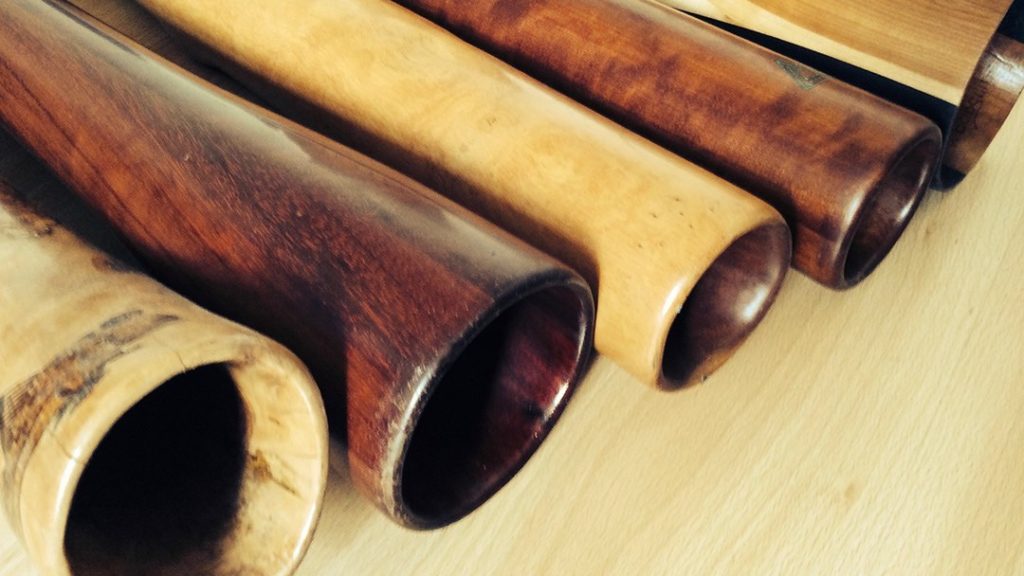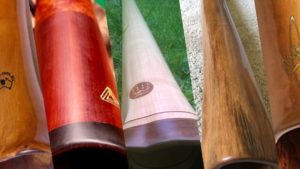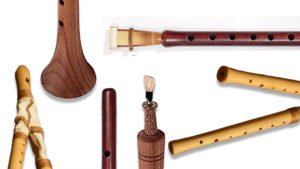Didgeridoos come in a range of pitches that extends over an entire octave, ranging from pretty low-sounding notes to pretty high-sounding notes. Be wary that it’s not easy for a beginner to choose the right note to start! When you begin to play the didgeridoo, you’ll likely have two questions come to mind. The first one is “What type of didgeridoo should I choose?” I covered that in the previous article. Then there’s “Which pitch would be best?” So, here I’ll discuss which pitch you should choose and how to judge whether it is suitable for you. To shed some light on this difficult question, we’ll take a step back and learn that didgeridoos are classified into three main families of notes, each of which has its own characteristics. Let’s check it out!
The 3 main didgeridoo families
You probably know that every didgeridoo has its fundamental pitch. This pitch depends on the dimensions of the didgeridoo and is the most important feature to be aware of. The most common pitches you’ll hear on didgeridoos range from A at the low end to G at the high end.
This piano keyboard show these notes:

Three colors, three didgeridoo families: In green: the low notes | In blue: the medium notes | In orange (weird, I’ll admit it): the high notes
In this diagram, you can see that the lowest common didgeridoo note is an A and the highest is a G#. There are didgeridoos that have fundamental pitches outside of this range, mainly in the low/bass notes. Dubravko Lapaine was one of those who introduced the bass didgeridoo by playing on extremely long instruments (over 3 meters long!). Of course, the more you go to such extremes, the more skill it takes to play that didgeridoo appropriately. Don’t start with a 3 meter long didgeridoo! On the other hand, beyond G# at the high end of the pitch range, we’re starting to trespass well into the territory of brass instruments, approaching the trumpet. Note that the didgeridoo doesn’t shine in these high pitches.
Leave them for the brass instruments!
Thus, the range of didgeridoo pitches can be grouped roughly into the following families: the low/bass notes, the mid-range notes and the high/treble notes. Keep reading for the details!
A – B-flat – B – C: The bass didgeridoo notes: warm but easily muddy
You could say the didgeridoos in this family are rather calm and easy going. They like to move slowly, rather like how their vibrations so gently propagate. These didgeridoos are often said to have a meditative aspect. You can still play pretty fast rhythms with them, but you will have to shake them up a little! However, they are generally pretty inviting. If you want a relaxing sound, choose a didgeridoo from this family!
On the other hand, you will quickly bump up against some limitations with sticks in this family. It will be difficult to find a didgeridoo in A on the market. Indeed, the deeper you plunge into the bass notes, the rarer will be the didgeridoos. This is mostly due to playability, but there’s also the issue of portability. A didgeridoo’s pitch is tightly linked to its dimensions, with deeper pitches usually meaning longer didgeridoos. A didgeridoo in A, for example, can easily reach a length of two meters, and it can be a lot of work to lug that baby around on the weekends!

My last didgeridoo to date: an excellent B from CrookedStixz
If you indeed want a didgeridoo from this family, then I recommend you begin with a C, the highest of the lows! As a result, they are also shorter and easier to play. Furthermore, you will be able to find them quite easily, because this is a popular pitch. The C has quite an advantage in having the low bass sound while still being rather easy to play. So, if your dream didge is something smooth and well-rounded, there is a good chance that a C would suit you.
Keep in mind that the lower you go into the bass range, the more earthy and cavernous the didgeridoos will become. To paint a better picture for you, it is as if you begin to discover a small enclave nestled in a cliff with a C. Then, with the B, you enter a cave, and A will have you descending into a pit. The lower you descend with the basses, the further you will go into the depths of the earth. Suffice it to say, a bass note pushed to the extreme can quickly become creepy and uncomfortable…
F – F# – G – G#: High note didgeridoos: from dynamism to nervousness
Here we have the polar opposite of the previous family…this is the home of the restless! This family is known to be responsive, maybe even jumpy and easily excited. In short, full of life! And you need a good deal of expertise to control all that, because otherwise they can quickly run away from you. However, once tamed, they have a substantial amount of natural dynamism. They are well-suited to playing rhythms and playing fast, but not much more.
We could add an A at the top, but no one really plays that note. Even the G# is really only for the extremists. With an A, we ‘ve exceeded the limit where the drone itself begins to sound like a trumpet (toot) tone of lower pitched didges. (The trumpet/toot tone is a didgeridoo technique used to play a brief note sounding well above the drone. You’ll learn about that later.)
In this family, your lips will vibrate quickly, and they will be tense. The rule to remember – and this is quite the opposite of the bass didgeridoos – is that the higher you go with the treble, the more tense your lips will become. This is why rhythms are often easier (at least initially) to play in this family of notes than with the bass note family. And because of this tension, the pressure is greater, which facilitates tongue attacks and thereby rhythmic playing.

One of my first didgeridoos, an F# of only one meter long with a large diameter. It is THE didgeridoo to avoid when you are just beginning!
Be careful though! As you might imagine, the line between dynamism and agitation is very quickly crossed. Just as the bass notes can become murky, high-pitched didgeridoos can be tiring and stressful if they are not mastered. It takes practice to play this type of instrument. Once again, the extremes which these can reach are demanding; the low notes demand a certain degree of suppleness while the high notes require good musculature.
If you really want to start playing in this high-pitched family, aim for a didgeridoo at the lower end – FA (F). However, I really do not recommend you make this choice. While a DO (C) is a good one to start with because its relaxed side adapts to the musculature of your body, a FA (F) will really push your breath and your muscles. Of course that will be difficult at the beginning. OK … it’s easy for me to write this, but truth be told, 6 months after having started, I bought an F# that turned out to be surprisingly difficult to play (darn!). It ended up being good training for me, as I had to learn to really pinch my lips and to blow with force! So, consider my advice, but it’s OK if you you don’t follow it to the letter.
C # – D – E-flat – E: The mid-range didgeridoos: the sweet spot?
This family occupies the middle ground, bridging the two extremes. And I’ll say straight out that this family is without a doubt the most balanced of the three. Add the fact that these didgeridoos tend to be a reasonable 1m40 long on average, and they are easily found at many retailers or makers. Moreover, here you find didgeridoos that are easier to learn how to play with continuous drone (often called circular breathing) and are responsive enough to encourage your first rhythms.
They offer the best of both worlds. The C# and the D offer the bass notes but with a vibration that maintains a comfortable amount of lip tension. These two notes will offer a relaxing sound, but they also offer good dynamics for the days when you are playing at your best! Meanwhile, the E-flat and E will play with a bit more tension (and will more easily play rhythmically) without being overly tense.

My favorite E, which I purchased second-hand during my tour in Russia in 2015
To summarize, we could say that a C# or a D is 2/3 meditative and 1/3 dynamic, while a E or E-flat is 2/3 dynamic and 1/3 meditative. That’s just a rule of thumb, but a pretty good one.
All of this to say these are the notes I recommend for those just beginning to play. They are both versatile and satisfying.
What do you want to play with your didgeridoo?
Like the rest of us, you are attracted by a particular sound of the didgeridoo – something that moved you when you heard it. Maybe it’s the relaxing side that grabbed you, or maybe it’s the rhythmic pulse. Perhaps for some players it might be the connection with nature, and a few players will like the natural “electro” aspect. Didgeridoo offers something for every taste! That thing that initially moved us is what will motivate us to play, so we want an instrument that can do that. I mean this article to be a “mini-guide” for you to understand the different didgeridoo pitches and their typical characteristics, however, it’s the same old song I’ve been singing all along: listen for yourself, and always choose a didgeridoo that moves you! That’s what counts.
How about ordering on the internet without trying it first?
OK… a didgeridoo that inspires you to play, yes; but not just any one! I have already talked about cheap didgeridoos to avoid and be forewarned that you probably won’t find many didgeridoos for sale nearby when looking to buy your first one. Short of having the luck to find a didgeridoo maker at a festival, one of the only choices you have will be to order it on the internet (I advise you to avoid music stores because they rarely know much about the didgeridoo). I’m hinting here that you probably won’t have the chance to test drive your future instrument before buying it.
So if you order your didgeridoo without trying it, I urge you to aim for the mid-range family or a C. This is where you will be less likely to go wrong (to read further about this: which didgeridoo should you choose when learning to play?).
In conclusion
Remember there are three main families. At the risk of over-simplifying: the bass notes are slow, the trebles are fast, and the mid-range family is a balance between these two. But if you are able to try out a didgeridoo and manage to make a good sound, then don’t even ask what pitch it is. Who cares? A good sound and playability count far more than the exact note it plays. All the rest is secondary! Finally, keep in mind that the instrument’s pitch is one thing, but its true character also depends a lot on the shape of the air column (for more on this see: 4 essential criteria to understand the psychology of your didgeridoo! ).
I hope to have clarified some points for you. Ask me any questions you might have in the comments section below! I would be happy to answer.













Always a pleasure to read your articles Gauthier! Thanks and regards. ~ Bala 😉
Thanks Bala! 🙂